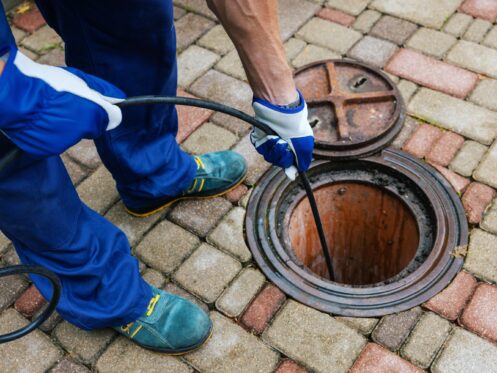Florida’s warm, rainy summertime climate isn’t just a challenge for your AC. It also plays a big role in how well your drains behave. Between tree root intrusion, grease buildup, and year-round outdoor debris, your pipes face more potential problems than you may realize.
At Plumbing, Cooling & Electrical Nerds, located in Southwest Florida, we work with homeowners to address challenging blockages and prevent backups before they escalate into more significant plumbing issues.
Why Florida’s Weather Intensifies Clogged Drains
Florida’s summer storms bring heavy rain and shifting soil that squeezes around buried pipes and roots. In Naples and Bonita Springs, there are ancient banyan and oak trees that pose a threat to your pipes. When those roots find a crack in a pipe, they grow inside and create blockages that slow or stop the flow of waste. If this happens in your yard, you might notice water backing up in showers, toilets gurgling when the washing machine runs, or foul odors from a bathtub drain.
Those signs often indicate a mainline clog forming underground. When that happens, you’ll need to call a plumber to clear the block. They will most likely use a method called hydro-jetting to flush out stuck debris and break down root clusters without destroying the pipe.
Hydro-Jetting vs. Snaking
When a pipe holds stagnant water, the question becomes how to clear it. In Fort Myers, many homes treat a blocked drain with a handheld snake. That tool grabs visible clogs near the trap, but it misses grease layers, mineral buildup, or roots farther down the pipe. Hydro-jetting service uses high-pressure water jets strong enough to peel away those layers of coatings and break up deep masses. For example, heavy rain often washes yard debris into outdoor drains, creating thick sludge in lateral lines. A snake won’t handle that, but a 3,000 psi hydro-jet system can.
The plumber may start with a regular drain cleaning to break up surface debris. Then they’ll follow that with hydro-jetting to scrub the entire pipe length. If roots reach into the main sewer, a single cleaning wand embedded with high-pressure nozzles can cut and flush them continually along the mainline. That keeps your system running smoothly, avoids backups during storms, and helps your drains shift from reactive fixes to long-term health.
Mainline Cleanout: Why It Should Be Your Go-To Access Point
Your home’s plumbing system includes a cleanout in the main sewer line. This access point is often capped and sits just outside the house or in the garage. A mainline cleanout provides access for maintenance work. When your drains back up regularly after a storm, cleaning only the trap may not resolve the root of the problem. Instead, the plumber will open the mainline cleanout, with its direct route toward the city sewer, and employ a hydro-jet or a large snake to clean the pipe.
This cleanout helps plumbers avoid crawling through crawlspaces or confronting tangled pipe layouts. For homes in the Naples area with older plumbing, mainline cleanouts also protect against tree root reinvasion. After a major cleaning, crews can insert a root-killing tablet or lining, and track pipe health with a quick video inspection.
How Drain Cleaning Reduces Emergency Plumbing Visits
When pipes clog in summer, you might find water coming out of a bathroom floor drain or hear odd gurgling sounds in sinks. These telltale signs often occur when microbial growth or fat from kitchen cooking accumulates on the inside of pipes.
Rainy Season Readiness: Time Your Maintenance
Florida’s weather follows a predictable pattern: the rainy season begins in late June and peaks by September. That means April and May are the ideal time to schedule drain cleaning, mainline cleanout, and hydro-jetting services. With that readiness, your home can withstand sudden storm surges and shifting groundwater levels.
A scheduled service in the spring or early summer typically costs less and offers better appointment availability. During the peak months, crews are booked for flood response and sewage backups, and prices may increase. Treat your home like a boating rig. You don’t wait until the storm hits to wax or check batteries.
How Free Water Quality Testing Fits Into Plumbing Prevention
Hard water, sediment, and mineral buildup can gradually narrow the diameter of your pipes, increasing the pressure required to push sludge and waste out. For that reason, the company offers free water quality testing.
High levels of iron or lime in your water can indicate the need for targeted solutions, such as sediment filters, which reduce deposits before they enter your plumbing. After testing your water, you and your plumber may consider installing a water softener that’s appropriate for your home’s chemistry. That helps maintain the hydro-jetting results longer by slowing deposit buildup.
You Aren’t Alone With Blocked Drains
Living in flood-prone communities like Bonita Springs or Naples, you might think sewer backups are unusual. In fact, they are common. Rainwater that mixes with your sewer line can cause sewage to back up into your drains. When pooled water presses in, check your floor drains and garage cleanouts for slow draining.
The weight of rain and shifting underground lines after a storm can cause seals to break. That can suck air or water into the line sideways. You can’t fix that by plunging. It requires a fresh mainline cleanout, a pressure test, and perhaps seal replacement. During your spring service, ask the plumber about replacing rubber seals in floor drains or installing flood-check valves.
DIY Isn’t Always the Answer
Roots that reach deep into older pipes can snap off and leave fragments. A home auger might shove them deeper or cause pipe damage by twisting inside weaker pipes. Hydro-jetting, handled by a professional, uses pressure gauges and hose restrictions to match the pipe size and integrity. That creates a safe and predictable cleaning process that avoids harm.
We don’t recommend store-bought chemical cleaners because they can erode pipe glazing, damage septic balance, or wash metal into downstream systems. Hydro-jetting removes clogs mechanically, eliminating the need for harsh chemicals.
What Happens After Hydro-Jetting
After hydro-jetting, you may still notice damp soil near the sewer connection. That indicates recent flushing and shouldn’t alarm you. Over the next few days, use indoor drains and allow the fresh water to naturally flow into the main sewer. You can pour a gallon of cool water down each major drain. The key is to keep the line flowing to prevent new buildup.
Solve Your Drain Problems Now
Drain issues rarely go away on their own. The longer you wait, the more your plumbing can strain under pressure, which can sometimes lead to broken pipes, water damage, or sewage backups. Whether you’re dealing with repeat clogs, a slow-draining shower, or want to understand how hydro-jetting fits into your maintenance plan, getting a pro on your side helps you solve the problem without trial and error.
We also offer a full range of plumbing services, including emergency repairs, water heater installations, and leak detection. Contact Plumbing, Cooling & Electrical Nerds today to keep your plumbing clear and trouble-free!

